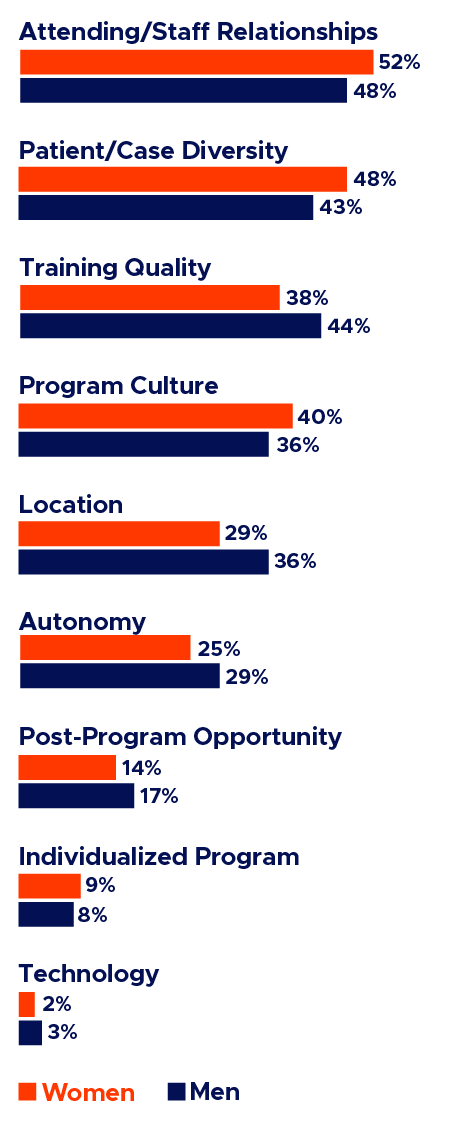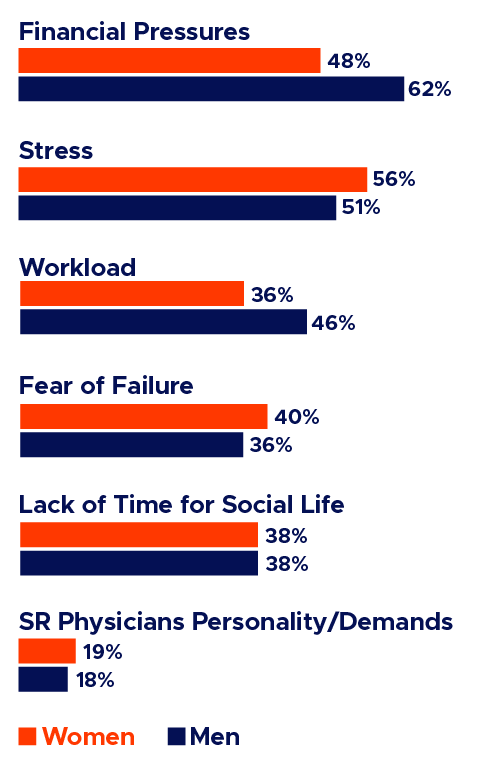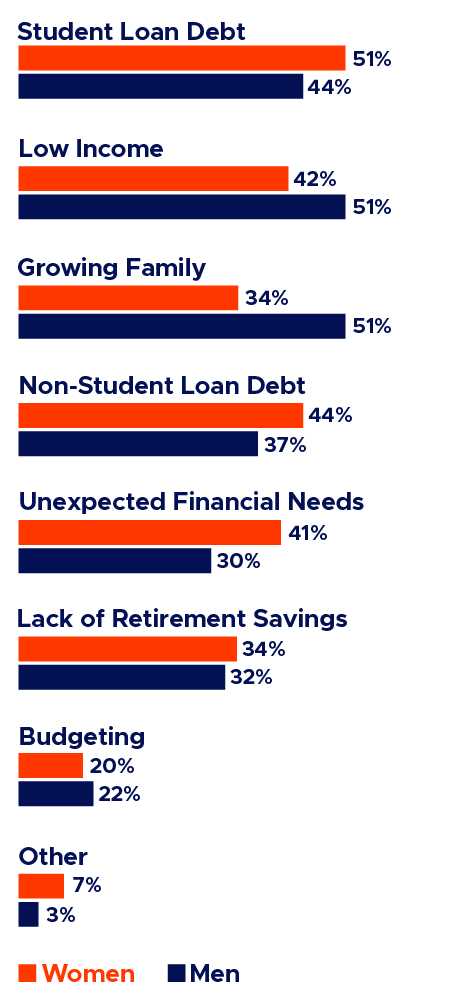Countless reports and first-hand accounts speak to the experiences of medical residents and fellows, but how do those experiences differ between male and female trainees?
We asked over 600 current residents and fellows in the U.S. to share their experiences and perspectives on compensation, debt, stress and more in the 2024 Residents & Fellows Survey Report. Let’s use that data to compare the answers of male and female trainees.
Differences
We found differences between male and female residents’ and fellows’ perspectives on extra work, non-student loan debt, post-training plans, burnout, and their best and most challenging parts of their training. Here’s what they said.
Extra Work
42% of male residents and fellows reported taking on extra work to supplement their income while in training, while only 32% of female residents and fellows reported taking on extra work.
| Do you take on extra work to supplement your income? | |
|---|---|
| Female | 32% |
| Male | 42% |
Of those who take on additional employment, men were more likely to moonlight* than women—72% compared to 54%.
| Do you moonlight? | |
|---|---|
| Female | 54% |
| Male | 72% |
*Moonlighting refers to working an additional job as a physician outside of your residency program.
Non-Student Debt
When asked if they had non-student loan debt, similar percentages of men and women answered yes, 66% of men and 65% of women. Broken down by type of debt, male and female residents and fellows differed.
A higher percentage of female trainees reported having a mortgage and credit card debt. More male trainees reported having auto or personal loan debt.
| Type of Debt | Female | Male |
|---|---|---|
| Mortgage | 30% | 23% |
| Automobile | 45% | 49% |
| Credit Cards | 83% | 76% |
| Personal Loans | 53% | 58% |
| Other | 2% | 3% |
Post-Training Plans
When asked about post-training plans, the majority of respondents (51.1%) indicated becoming an employed physician. Plans also included academic medicine (27.1%) and practice ownership (17.1%).
When broken down by gender though, responses differed for post-training plans. Women were more likely to plan to enter academic medicine, 32.5% vs. 22%, and men were more likely to plan for practice ownership, 23.5% vs. 12%.
| Female | Male | |
|---|---|---|
| Academic Medicine | 32.5% | 22% |
| Employed Physician | 49% | 51.5% |
| Practice Ownership (including partnership) | 12% | 23.5% |
| Other | 6.5% | 3% |
Burnout
On a scale from 1 (rarely) to 10 (daily), female residents and fellows reported higher frequency of burnout (7.1) than their male colleagues (6.4).
| Frequency of Burnout (Out of 10) | |
|---|---|
| Female | 7.1 |
| Male | 6.4 |
Best & Most Challenging Parts of Training

We asked residents and fellows about the best and most challenging parts of training (choose their top three), and answers differed between male and female respondents.
A higher percentage of female residents and fellows reported enjoying the diversity of patients and cases and their relationships with staff, attendings and other residents. Male trainees reflected more positively than female trainees on the location of their program and quality of clinical training.
*Respondents could choose up to three

*Respondents could choose up to three
Similarities
Despite the differences listed above, there were many similarities between male and female residents, including their salaries, satisfaction with compensation, financial stress and student loan debt.
Salary
According to our survey, the average salary for residents and fellows was $67,746. When divided by gender, the salaries did not differ significantly between men and women. Male residents and fellows reported earning an average of $68,271 annually. Female residents and fellows earned just slightly less, $67,142.
| Salary | |
|---|---|
| Female | $67,142 |
| Male | $68,271 |
See also: Infographic: Medical Residents’ & Fellows’ Compensation
Compensation Satisfaction
Male and female residents and fellows were similarly satisfied (or rather, not satisfied) with their compensation. Men’s satisfaction ratings averaged to 4.6 out of 10 (1 being very unsatisfied, 10 being very satisfied). Women’s average was 4.7 out of 10.
| Compensation Satisfaction (Out of 10) | |
|---|---|
| Female | 4.7 |
| Male | 4.6 |
Financial Stress
Financial stress levels were similar for both male and female residents and fellows. Male residents and fellows rated their stress at an average of 7.5 out of 10 (1 being no stress, 10 being very stressed). Female trainees rated their stress at a 7.4 out of 10.
| Financial Stress (Out of 10) | |
|---|---|
| Female | 7.4 |
| Male | 7.5 |

Student Loan Debt
More than three-quarters (78%) of female residents and fellows and 75% of male trainees reported having student loan debt. The average amount of student debt is similar for both men and women—$296,874 and $295,860, respectively.
Navigating Residency
No matter your demographics, residency and fellowship training will have its challenges. We hope that this data will provide insight into this step of your past, current or future career. Find the full survey report here.




